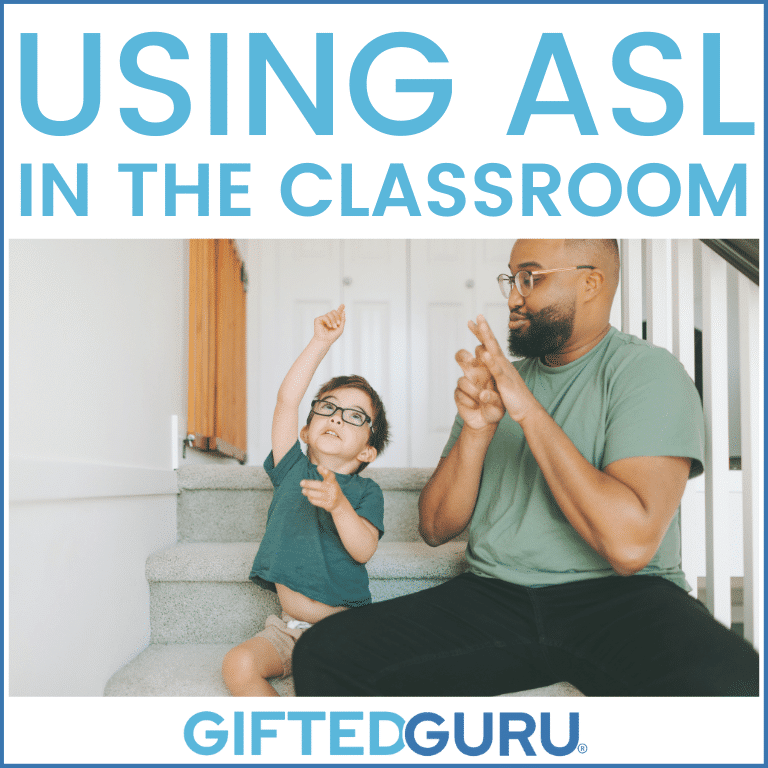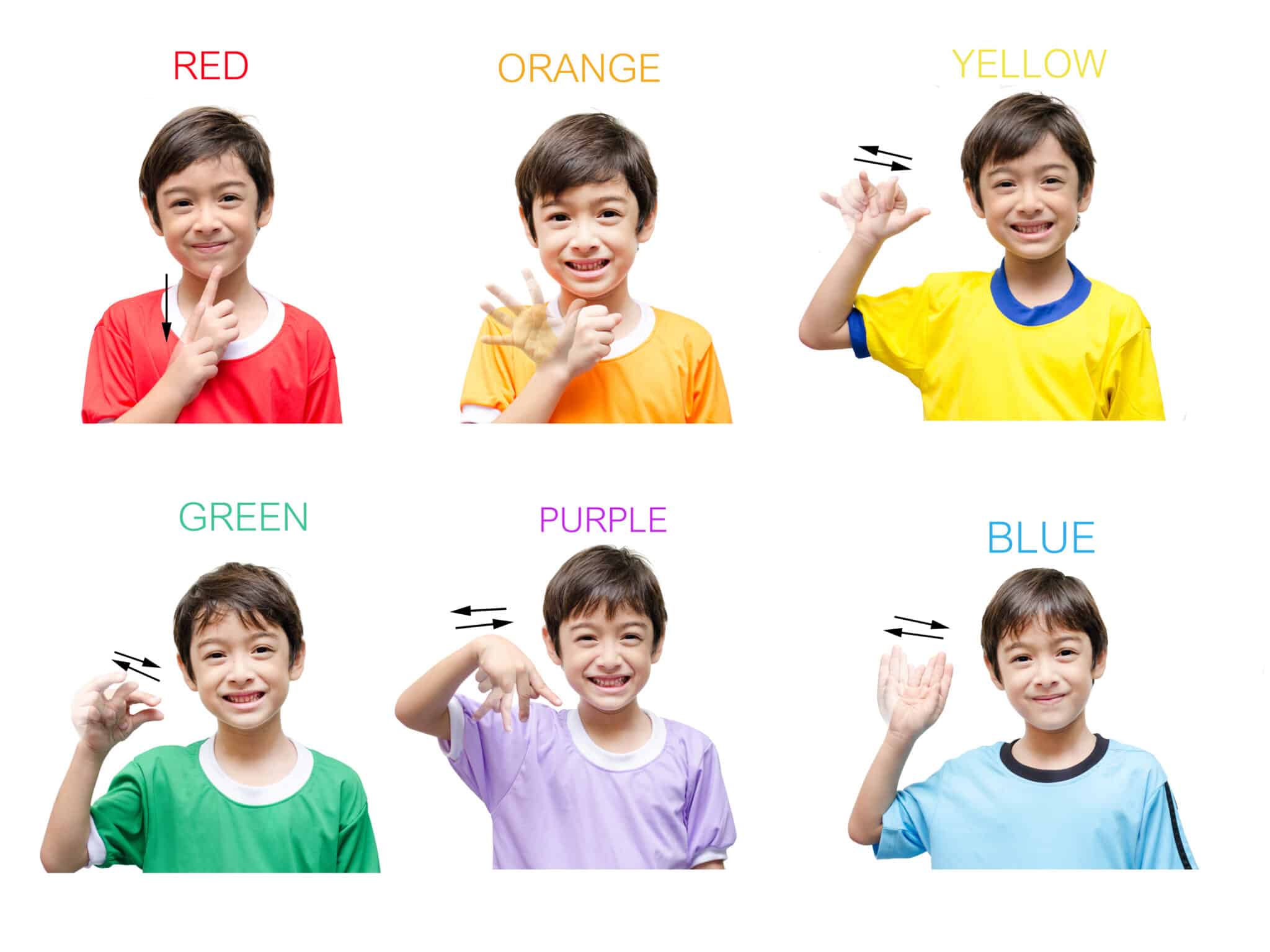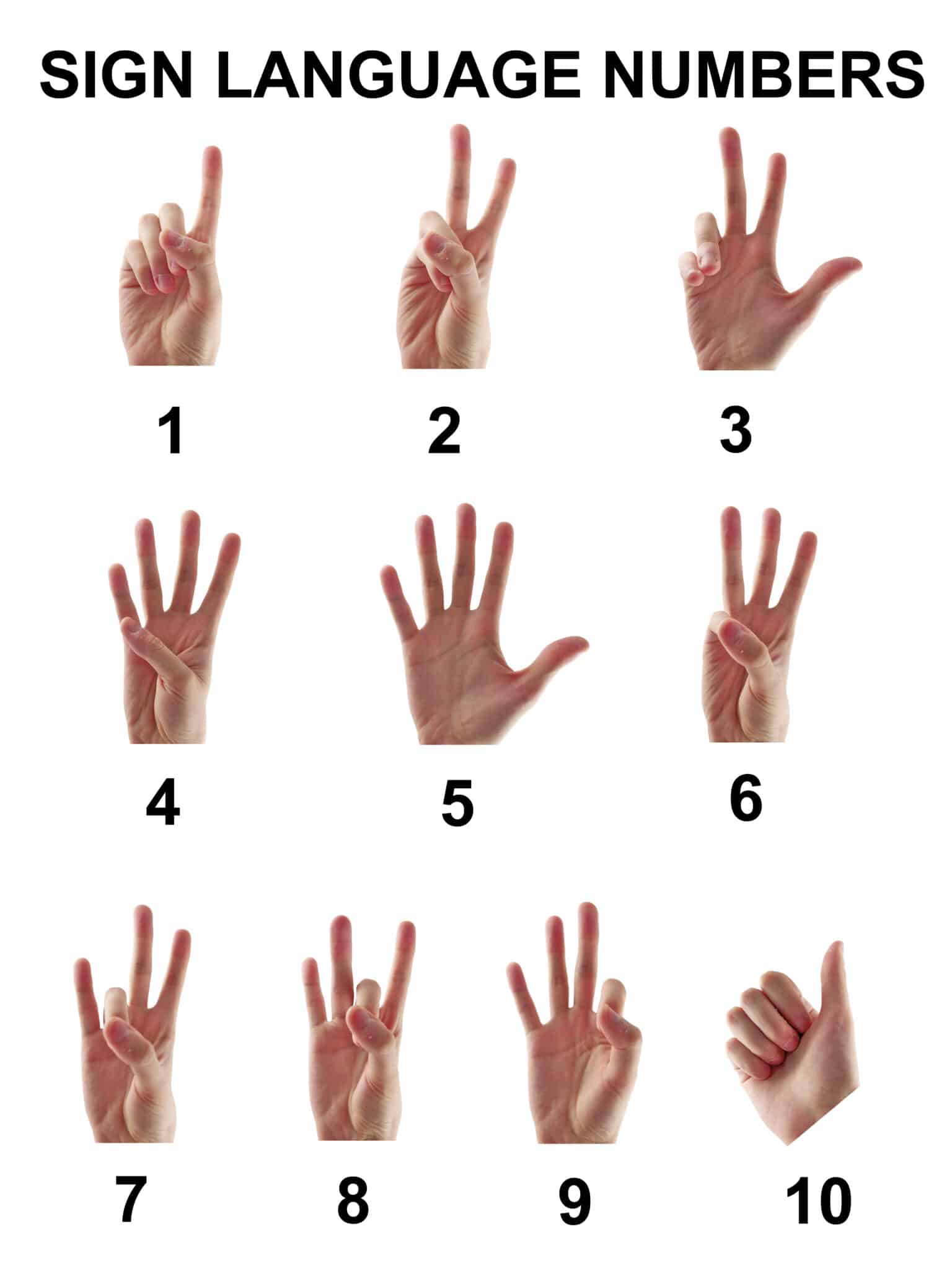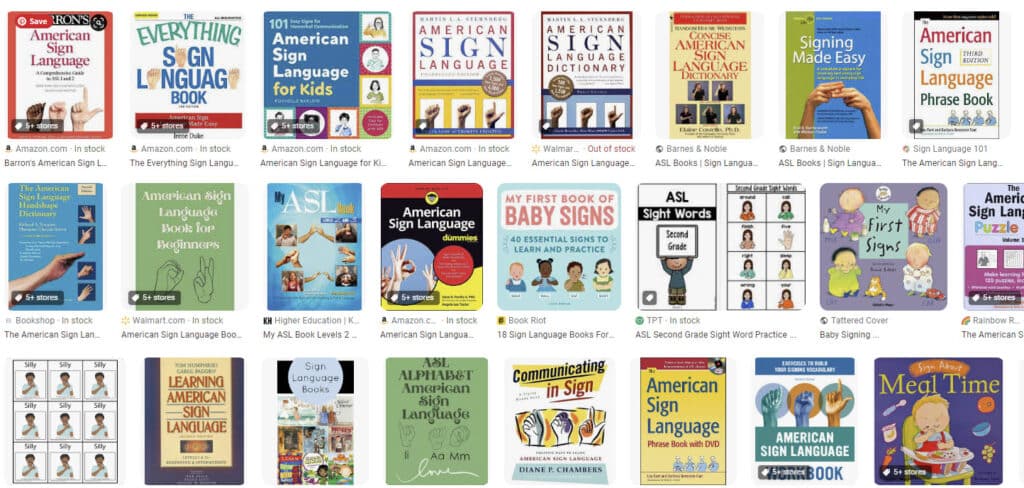ASL has a place in every classroom.
Because I specialize in the education of gifted and talented students, I often cross paths with students who have atypical learning needs. ASL is a great fit for students with learning disabilities, for students with amazing learning abilities, and for those who are typical learners.
Why do I think Sign Language is so great?
I could sign before I could speak, according to my grandfather.
He would know: he was Deaf, and he was the one who taught me sign language. He was older, and he used Signed English.
ASL is more commonly used now, and you will find it to be a tremendous asset in your classroom.
As a teacher, even four or five signs can make a big difference. I used ASL in my regular education classroom, and I think it can be a benefit to you, too. The woman in the photo below is signing “yes,” and I think you’ll say yes to ASL once you know all of the amazing benefits it offers educators!
What are the benefits of using ASL in the classroom?
ASL (American Sign Language) can be a good fit for a classroom for several reasons.
Learning ASL can promote inclusivity and understanding of diverse cultures. The deaf community has a rich history and culture, and learning ASL can help hearing students better understand and appreciate this culture.
That’s valuable by itself, but there are many more benefits to using ASL in the classroom. I came up with twenty-five, and I think there are many, many more. Research studies are cited at the bottom of the article.
25 benefits of using ASL in the classroom
- Language Development: ASL can be a useful tool for promoting language development and literacy in young children. Research has shown that learning a second language, such as ASL, can have cognitive benefits and can improve a child’s ability to learn additional languages in the future.
- ASL can be a valuable tool for supporting students who are deaf or hard of hearing, as it allows them to fully participate in classroom discussions and activities.
- It’s fun! Learning ASL can be a fun and engaging activity for students of all ages, as it involves learning a new mode of communication and allows for creative expression. It may even turn into a hobby.
- ASL is a nonverbal means of communication that can be helpful in managing noise levels and behavior in the classroom. (More about that later!)
- The teacher will have an ability to communicate rules and expectations to all students, including those who are deaf or hard of hearing, even when it’s loud around you.
- ASL Promotes a positive classroom culture. It becomes a part of your unique classroom culture.
- Students who sign have stronger visual/mental imagery.
- Finger spelling improves spelling skills.
- ASL increases students’ problem-solving and critical thinking skills.
- It can improve memory and cognitive skills. The more paths a piece of information has, the easier retrieval becomes.
- ASL increases students’ self-esteem and confidence. My students loved showing what they knew. They loved impressing adults with their ability to follow instruction silently. It’s empowering.
- ASL is a school safety skill. In case of lockdown, I can communicate to my students in complete silence. I wish this weren’t a thing, but it is.
- As another path of communication, ASL increases the communication in the classroom. This is part of why it’s such a strong classroom management strategy.
- Decreasing unproductive frustration is one of the most important things I do as a teacher. Because ASL allows me to communicate without interrupting, it decreases the frustration that comes from waiting to ask a simple question.
- Because you have to look at the person, ASL forces focus.
- ASL builds students’ imitation skills.
- Learning ASL can also help promote a positive classroom culture by promoting inclusivity and understanding of diverse cultures. When students learn and use ASL, it can help create a sense of community and support in the classroom. It normalizes differences.
- For young students, many signs match letter forms, so it helps with letter recognition.
- If you teach the numbers, you can have endless math facts practice without complaining. Gamechanging!
- With ASL, you can provide information in a visual way to accompany your words. This helps students with Autism Spectrum Disorder and ADHD.
- Impress administrators. Sometimes it’s hard to convey your strengths as a teacher in a quick walk-through. With ASL, administrators can gauge your effectiveness very quickly because they will see you juggling the entire class with ease. It’s not the impressing part that’s important – it’s that you can give a better core sample of your strengths.
- Because of its form, ASL offers students a kinesthetic opportunity that is on task.
- ASL builds empathy, as students develop better connection with students who are non-verbal or who have other needs.
- ASL increases peer-to-peer interaction.
- You will save instructional time when you use ASL because you will decrease student downtime. Rather that having a line of students waiting to ask questions such as, “May I go to the restroom?” or “May I sharpen my pencil?,” you’ll be able to quickly and seamlessly respond to such requests silently while continuing what you were doing.
What are some of the ways ASL can be useful in classroom management?
Using ASL for classroom management is why I started in the first place. Later, the other benefits revealed themselves.
ASL (American Sign Language) can be a useful tool for classroom management in a few ways:
- Classroom management is largely dependent on the power and depth of classroom culture. The stronger the culture, the easier the management.
- Anything unique builds culture. Because most classes are not using ASL, your students will feel a unique identity as the class that does.
- You can correct students without drawing attention to them. A simple sign reminds them to wait, to be quiet, to speak up, etc.
- You’re teaching something other than the content, so even if they don’t feel successful that day with the objective, they can still build confidence. That reduces frustration and feelings of helplessness that can lead to acting out.
- You can direct students in noisy environments. I can get my kids from their table in the cafeteria and back to class in complete silence.I can get them to the blacktop during a firedrill (and back) without saying a word. I can get them in from recess with ease, even though I cannot be heard over the other voices.
The list goes on and on. I cannot imagine trying to manage my classroom without ASL. The signs I’ve found most helpful have been those that answer quick questions. The sign for “later” is one I use dozens of times a day!
The most important way it helps with classroom management is that students get used to looking at you. Sounds simple, but it’s harder than it seems.
What are the most important 50 signs teachers need in the classroom?
Fifty signs may seem like a lot, but you will be shocked at how quickly you pick them up. You’ll also find that once you start using ASL, you’ll want more signs because you see how effective ASL in the classroom can be.
I’m listing the top 50 signs I think every teacher can use.
1. Yes
2. No
3. Maybe
4. Please
5. Thank you
6. Now
7. Later
8. Tomorrow
9. Bathroom
10. Water
11. Lunch
12. Start
13. Finish/done
14. Pencil
15. Paper
16. Pen
17. Computer
18. Sit
19. Stand
20. Take
21. Give
22. Line up
23. Clean
24. Come
25. Go/go to
26. Quiet
27. Focus
28. Alone
29. Together
30. Group
31. In
32. Out
33. Read
34. Draw
35. Write
36. Speak
37. Classroom
38. Office
39. Nurse
40. Counselor
41. Cafeteria
42. Recess
43. Library
44. Gym/PE
45. Good/good job/Deaf clap
46. Happy
47. Sad
48. Frustrated
49. Angry
50. Hello/goodbye
I’d also recommend the numbers from 1-10 and the alphabet, but I didn’t want to count them because that would be 36 more signs, technically!
Being able to count down from 3 to 1 is a critical skill!
Where is the best place for teachers to learn ASL signs?
My suggestion is YouTube. Simply go to the YouTube search bar and type, “how to sign XXX in ASL.”
Now, there are people who will argue that you’ll sometimes get poor quality instruction that way. My reply would be that people can be too picky.
There are a number of channels that teach ASL.
My favorites are:
- Learn How to Sign is my favorite. Really, you only need this one.
- ASL Rochelle
- ASL Meredith
- Chris Gorges
If you don’t like YouTube, the two websites I’d mention are:
You’ll notice that I’m not giving a lengthy list. Don’t get overwhelmed!
When I’m learning a new sign, I typically look it up in a couple of places to get a feel for different angles and styles.
Other Resources
A quick search of books about ASL will quickly overwhelm you.
I have a few favorite books and tools I use in my ASL study. Yes, I’m still studying! Signs change over time, just like any language, so I have to stay on top of my ASL game.
Here are a few of my suggestions (these are affiliate links):
- Sign Language for Kids: This popular book has children as models for the signs, which is a plus for students. It says it’s for grades 3 – 7, but I think it’s fine even for 2nd and through high school.
- I absolutely love these wordsearch books of fingerspelling to help with receptive skills. When I searched for the link on Amazon, I found I’ve ordered them multiple times because I keep giving them to students!
- If you’re a math teacher, you’ll want Number in American Sign Language: Number Signs for Everyone.
- Talking with Your Hands Listening with Your Eyes: This book is out of print at the time of writing, but you can grab a used copy for just a few dollar.
- If you find yourself getting serious, this is the ASL dictionary I use.
While there are colorfully illustrated books for children, I don’t recommend them because I find the clarity lacking in the signs.
What are the different skills needed to communicate with ASL?
There are two types of skills needed to communicate in ASL, receptive and expressive.
In American Sign Language (ASL), receptive skills refer to the ability to understand and comprehend signed language, while expressive skills refer to the ability to produce and use signed language to communicate with others.
Receptive skills in ASL can include the ability to:
- Understand signed language when it is used by others
- Follow signed instructions or directions
- Comprehend signed stories or narratives
- Understand and interpret signed facial expressions, body language, and other nonverbal cues
Expressive skills in ASL can include the ability to:
- Produce signed language accurately and fluently
- Use signed facial expressions, body language, and other nonverbal cues to convey meaning
- Use signed language to express thoughts, feelings, and ideas
- Use signed language to engage in conversation with others
Both receptive and expressive skills are important for effective communication in ASL, so make sure students practice both.
It won’t do any good if students can produce signs but not read signs others are using.
What are the important dates for Deaf awareness?
If you’re using ASL in your classroom, you may wish to take note of Deaf awareness days.
Deaf Awareness Week is typically observed during the last full week of September, in conjunction with International Week of the Deaf.
This week is an opportunity to raise awareness about the deaf community and the issues that they face, such as access to education, employment, and communication. In addition to Deaf Awareness Week, there are also several other days throughout the year that are dedicated to raising awareness about deafness and the deaf community.
These include:
- January 4th: World Braille Day
- March 13th: World Hearing Day
- May 5th: International Day of the Deaf
Try Using ASL in the classroom
I could list benefits and tips for days, but as someone who grew up immersed in Deaf culture, my most important suggestion would be to just start. Learn a few simple signs (yes, no, later) and go from there.
If you start to feel frustrated, take a break. If you have students who love it, let them teach some signs to the class. You could even have an ASL center in the classroom with flash cards, ASL fingerspelling wordsearches, and other activities.
From one teacher to another, ASL is one of the most impactful things I can share with you. And it’s free! So try it out and see the power it can give you as an educator.
The Research
Here are just a few of the research studies that support ASL use in the classroom as a path to student achievement:
Cook, S.W., Z. Mitchell, and S. Goldin-Meadow, Gesturing makes learning last. Cognition, 2008. 106: p. 1047-1058.
Koehler, L. and L. Loyd, Using fingerspelling/manual signs to facilitate reading and spelling, in Biennial Conference of the International Society for Augmentative and Alternative Communication. 1986: Cardiff, Wales.
McKnight, J., Using the manual alphabet in teaching reading to learning disabled children. Journal of Learning Disabilities, 1979. 12: p. 581-584.
Peressotti F, Scaltritti M, Miozzo M (2018) Can sign language make you better at hand processing?
Robertson, S. Using sign to facilitate expressive vocabulary in late talkers, in American Speech-Language-Hearing Association. 2004. Philadelphia, PA.
Vallotton, C.D., K.B. Decker, and M. Fusaro. A bridge to somewhere: Symbolic gestures as concrete representations that build towards abstract ones, in XVIIth Biennial International Conference on Infant Studies. 2010. Baltimore, MD.
Vernon, M., et al., Using sign language to remediate severe reading problems. Journal of Learning Disabilities, 1980. 13: p. 215-218.














